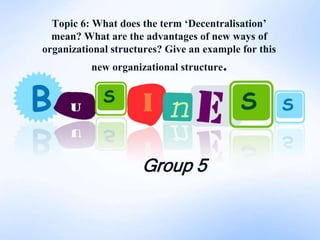
Advantages of Decentralization
- 1. Topic 6: What does the term ‘Decentralisation’ mean? What are the advantages of new ways of organizational structures? Give an example for this new organizational structure. Group 5
- 2. Outline I. Introduction II. Content 2.1 Definition of Decentralization 2.2 Comparison between Centralization and Decentralization 2.3 An examples of decentralization 2.4 Advantages of Decentralization III. Conclusion
- 3. I. Introduction • Organizational structure: - The outline of a company’s framework. - Guidelines for managing business operations. • Two main types: centralization and decentralization.
- 4. 2. Definition. • Decentralization: - the assignment of logical. - the transfer of responsibility for planning, management. • Each level has the authority to act, promote dynamism. • Several individuals responsible for making business decisions and running the business
- 5. Q: Two digrams of organizational structures. Which is the diagram of Decentralization? 1 2 a.1 b.2 c.Both 1 and 2 d.Neither 1 nor 2
- 6. 3. Comparision. Centralization Decentralization - Making decisions and - Making decisions and provide direction: provide direction: One individual The numerous managers - Applying: + Each manager is responsible + Small businesses for few employees and 1 or 2 + the owner is responsible for job functions everything.
- 7. 4. Example Clarion University’s student newspaper advertising services.
- 8. 5. Advantages. 1. Reduces burden of top executives. - Concentrate on more important functions. - Extend leadership. 2. Quick and better decisions. - Making accurate decisions without consulting higher levels.
- 9. 3. Growth and diversification. - Facilitate growth and diversification of products and markets. 4. Better communication. - Improve organizational communication. - Reduce bureaucracy. 5. Development of executives. - Make for stability and continuity of the company. - Promote autonomy, initiative and creativity of subordinates.
- 10. 6. Improvement in motivation and morale. - Improve the job satisfaction and morale of subordinates. 7. Effective supervision and control. - Result in effective supervision. - Promote effective control. 8. Democratic management. -Make flexible operation.
- 11. 6. Conclusion. • Decentralized organizations are becoming more popular. • Decentralization is an organization's form of freedom. • Companies are able to take advantage of decentralized structure to gain better business growth faster.
- 12. Questions Q: How many advantages were given in our presentation? a. 5 b. 6 c. 7 d. 8 Q: In our example, Clarion Call is... a. A newspaper. b. A store. c. A person. d. A city.
